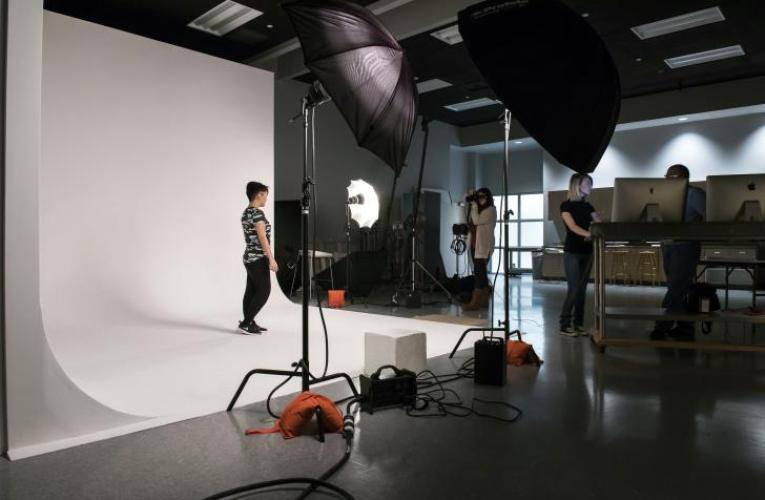
VisCom students excited to learn how to utilize new cyclorama wall

ATHENS, Ohio—During winter break, the School of Visual Communication worked hard to complete their new cyclorama wall so it would be ready for students to use during spring semester.
The VisCom cyclorama wall, often shortened to “cyc wall”, is made of two walls, approximately 12 feet tall and 12 feet wide, joined at a 90-degree angle with a natural curve added to the bottom junction and center corner. The curves add an illusion of space and widens the usable area for the background of a photography shoot.
“The cyc wall is an important part of commercial photography because it allows students to set things up on the wall so it looks like they are floating in the middle of nowhere, it creates a seamless background,” said Tim Goheen, director of the School of Visual Communication. “Because the cyc wall is painted all white, it allows a photographer to mask the white out easily and replace it with different colors or backgrounds in Photoshop.”
The new cyc wall is designed for use by faculty and students, both graduate and undergraduate, in the School Visual Communication. Undergraduate students that are seniors and graduate students who are taking courses that focus on commercial photography or advanced photographic illustration have primary access to the cyc wall. However, Associate Professor Gary Kirksey says that other projects could come up which would allow students access to shoot in the studio.
“We could bring a large item in for a still life class and photograph it on the cyc wall,” said Kirksey. “Our seamless paper is only 9 feet wide, so if you’ve got a large item, it’s really easy to go over the edges of that seamless paper and for your images to not be as effective. Whereas, with the cyc wall, we can bring a motorcycle in on the freight elevator, and easily put it on the cyc wall, or other objects, like a dresser, or do a fashion shot.”
Senior photojournalism student, Michael Pronzato, has already jumped at the chance to get in the studio and learn how to use the cyc wall. Last semester he took VICO 3227, a fashion and portraiture course, and is now working on an independent study with Associate Professor Larry Hamel-Lambert. Pronzato’s prior course experience and project with Hamel-Lambert have him working on the cyc wall shooting the skateboarders of Athens.
When asked what he thought of the cyc wall, Pronzato replied, “It’s really cool. It’s definitely a lot of space that they [the skateboarders] can use. But the cyc wall is bigger than the seamless paper, which I really like, so you can get super wide shots. I might do another project after this one, just to use the cyc wall again. I want to experiment with the light, I want to learn how to use lights more with different set-ups in this space.”
Before moving to the new Steven L. Schoonover Center for Communication, the School of Visual Communication had a cyc wall in Seigfred Hall that was utilized for several decades. Once the decision was made to move the school into Schoonover Center it made sense to have a new cyc wall built in a studio space here to replace the old cyc wall.
“The most difficult thing about a cyc wall, is that it comes towards the ground and then it has a natural curve with no seams, and that is the hardest thing to build,” said Goheen. “I found Todd Dean, at Affordable Cyc Walls in Columbus, online and he told me that he donates a cyc wall to one school every year because it is good advertising for his company, a word-of-mouth type of thing, and he wanted to do it before the end of the fiscal year. It worked out, and Todd donated the cyc wall to the Ohio University School of Visual Communication, we had a contractor build the actual walls and then he came in and built the curvature of the cyc wall over winter break.”
The cyc wall itself is massively impressive when you walk into the studio and it dominates the room. The curve of the wall itself is a unique design by Dean’s company that makes it both strong, but flexible. According to his website, the cyc wall curve is created from “solid high density polystyrene structure and covered in a polymer cement.” To strengthen the connection of Dean’s donation even more, he is an Ohio University alumnus, HTC ’86 in film tutorial. The walls were cleverly designed, with input from Hamel-Lambert, the contractor designed the back of the walls to have storage compartments, so camera and studio equipment could be placed out of sight behind the cyc wall.
“The ability to learn how to light a cyc wall, the ability to make photographs that are a little bit better for their portfolio, I think that’s the primary benefit of the new cyc wall for our students,” said Kirksey. “I think it’s good for us as a recruiting standpoint, because very few schools have anything like this, so when you give a tour of our facility and you show that wall off to people, it’s quite impressive. We’re getting more competition from other state schools, and here’s something that they don’t have.”
The VisCom cyc wall is located in Schoonover Center, Room 445D, on the fourth floor. To learn more, email Gary Kirksey at kirksey@ohio.edu or call 740.593.4893.
